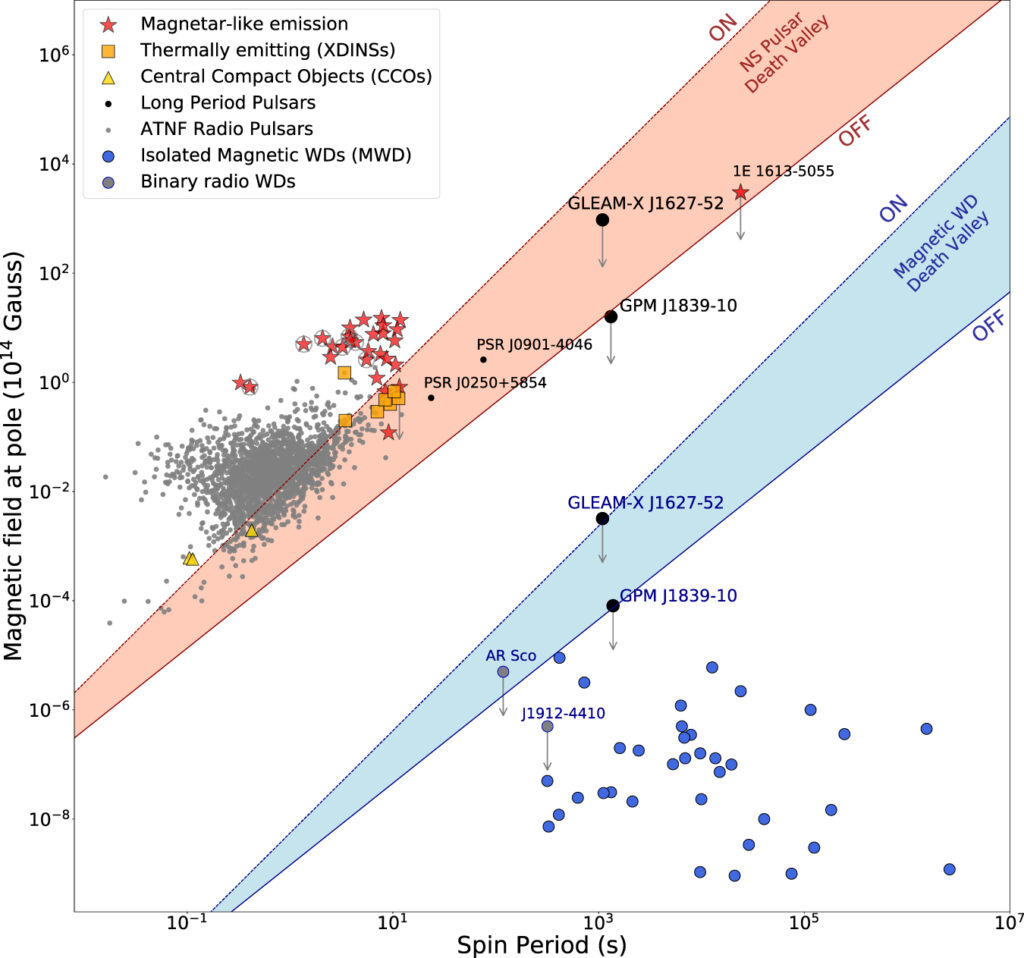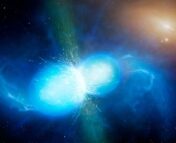Authors: Nanda Rea, Natasha Hurley-Walker, Celsa Pardo-Araujo, Michele Ronchi, Vanessa Graber, Francesco Coti Zelati, Domitilla De Martino, Arash Bahramian, Sam J. McSweeney, Tim J. Galvin, Scott D. Hyman, and M. Dall’Ora
First Author’s Institution: Institute of Space Sciences (ICE-CSIC), Barcelona, Spain
Status: Published in APJ [open access]
Earth is constantly being bombarded by radio waves from all across the Milky Way Galaxy. The shorter time-scale signals, known as ‘radio transients’, can sometimes be periodic. These periodic signals are often attributed to rotating neutron stars (NSs), which act as a sort of cosmic lighthouse, sending out regular flashes of radio ‘pulses’. Normally the slowest of these sources send signals on the order of milliseconds to seconds. However, the recent detection of two ultra-long signals, each with an astounding period of 18 and 21 minutes, has completely surpassed even the slowest signals previously detected. What could be causing these ultra-long period radio signals, and what can they tell us about the populations of extreme compact objects they come from? The authors of today’s paper investigate these very questions.
Time for a mystery
GLEAM-X J1627-52 and GPM J1839-10 (astronomers love brevity) are the names given to these two ultra-long periodic radio transients. Amazingly, based on archival data, it turns out GPM J1839−10 has been active for at least 33 years! It is still a great mystery what kind of object could produce such a long period signal, but two kinds of stars might be the culprits.
The first is white dwarfs (WDs), Earth-sized stars that form towards the end of the lifecycle of intermediate mass stars like the Sun. WDs often have slower rotation periods but there is no known mechanism by which WDs could produce the same bright radio signals. It is thought that a companion star could possibly enhance the WD’s radio emission via stellar wind. As the white dwarf’s emission beams cross through this stellar wind, it accelerates the electrons within it, releasing radio waves as these accelerated electrons interact with the white dwarf’s magnetosphere.
Only two radio emitting WDs have ever been observed, and both were in a binary system. Yet GLEAM-X J1627−52, based on a lack of an optical or infrared component, is likely not in a main-sequence binary system similar to these radio emitting WDs. It could still have a low mass companion, such as in the AR-Scorpii system, a white dwarf pulsar binary containing a low mass, red dwarf companion star (learn more about AR-Scorpii in this Astrobite). GPM J1839-10 has not yet been constrained to be in a binary using optical and infrared observations.
The second potential source is highly magnetized NSs, known as magnetars. These magnetars are the extremely dense, extremely magnetic leftovers of stellar explosions. How dense and how magnetic you might ask? Just one tablespoon of magnetar matter weighs as much as Mount Everest, and their magnetic fields, which are a thousand trillion times that of Earth’s, make them the most magnetic objects known. Magnetars tap directly into their magnetic fields to fuel their powerful jets of radio waves.
Not so perfect sources
Despite the amazing properties of both these objects, the authors find several issues when trying to explain GLEAM-X J1627-52 and GPM J1839-10 using WDs or magnetars. While observations from back in 2018 show GLEAM-X J1627−52 does have a brightness and polarization similar to other radio magnetars, X-ray measurements put limits on it that challenge a magnetar being responsible. The ultra-long period is also not in line with the rest of the neutron star population. On the other hand, WDs are not known to produce the same bright emission observed.
Crossing the line
To figure out whether NSs or WDs might be responsible for these long period signals, the authors use two methods: death-line analyses and population synthesis simulations.
Death line sounds like an ominous term, but it simply defines the threshold at which radio emitters no longer put out bright enough signals for us to detect with our telescopes, meaning they are effectively ‘dead’. The authors create a range of death lines (shown in Figure 1), based on the simplest models available, to more extreme models that incorporate complicated physics like twisted magnetic field lines.

Based on these death lines, the authors conclude that NSs could create the type of signal seen from GLEAM-X J1627−52, but not for GPM J1839-10, since it falls below even the most extreme death line. The same is true for magnetized WDs.
The second method is called population synthesis, which uses statistics from the already existing sample of NSs and WDs to try and simulate the total population of these stars. The authors vary different parameters like magnetic field strength, birth rate, and the angle between the magnetic field axis and rotational axis to try and figure out if a special population of NSs or WDs might exist in the Galaxy with these slow periods.
The authors find that a large population of long period radio emitters cannot be easily explained by NSs, even when assuming extremes like no magnetic field decay, stronger magnetic fields, etc. The WD population synthesis shows magnetized WDs with long periods are more common, but isolated WDs are not expected to be able to emit bright, coherent (constant phase) radio emission, based on the existing population.
This is likely just the first step in uncovering an entire unknown population of ultra-long period radio transients. Many more sources like this could be out there, but for now the authors recognize that the sample size is small. If either of the two signals, GLEAM-X J1627−52 or GPM J1839-10, is confirmed to be a NS or WD in the future, it will tell us a lot about the physics of these extreme objects. It may even require a revision of our understanding of NSs or WDs, both in terms of how exactly they emit radio waves, and what their populations look like in the Galaxy!
Astrobite edited by Maryum Sayeed and Annelia Anderson
Featured image credit: Pete Wheeler, ICRAR (2016)




